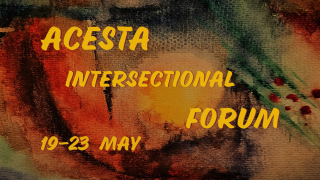
Summary notes by Tatiana Arvellos
Day 1
Monday, May 19, 2025
Arrival & Registration from 11:30 am
1:45 - Tour around Emerson college to see where the new RMT garden school is being built (Aongus Gordon, Constantine Court)
2:20 Introduction by Paulamaria and Simon Blaxland-de-Lange
Session Notes & Highlights
1. Opening by Paulamaria with a Steiner’s Verse.
Introduction of the forum.
Paulamaria acknowledged the absence of some participants from the new caring group, specifically Emma, due to a family bereavement and Spencer to working duties with lambs arriving on the farm and therefore had sent their apologies for this time.
2. New Section Introduction – Section for Inclusive Social Development
An open question was posed: “How does ACESTA relate to his new Section and how can we populate this new section?”
This marked the start of envisioning future growth and participation in ACESTA’s evolving structure.
Simon has been a long-time member across many of the sections, officially opened the conference with a reflective and forward-looking presentation.
His talk framed the forum in terms of:
What ACESTA was; What it is today and What it could become.
Key points from Simon’s talk
Historical Context
Recalled ACESTA’s foundational gathering in January 2003 in Nutley Hall, and the development of key ideas and methodologies related to spiritual science, with what was then called curative education, and social therapeutic work.
Referenced Dr. McGavin and others who helped shape the movement’s direction and all the work that has been put into Acesta to be recognizable for what it was and what it wanted to achieve in a fully spiritual scientific developed way and within the regulatory requirements.
Simon recalled and mentioned other important names from Acesta’s rich history such as Edeline Lefevre (a long-term membership secretary); Piet Blok (treasurer for many years); Maria van den Berg and Jack Reed.
Reflection and Renewal
Called for a “reworking” and “re-understanding” of spiritual science.
Emphasized self-knowledge and research into the unknown, alongside the need for collaboration and adaptation in changing times.
Future Directions
Advocated for the rejuvenation of ACESTA’s structure, especially:
Strengthening general section-work, Human Development, Social Development, and Therapeutic Work.
Encouraging interdisciplinary dialogue and self-organized contributions from members.
Simon shared reflections on what Steiner was able to give in his last years, implying a deeper need for commitment and creativity in the present.
Paulamaria reflected on how ACESTA has functioned as a professional association that brings people together who seek a platform to connect, collaborate, and engage across disciplines. It has provided both a multidisciplinary forum and the space for the new section and initiatives to emerge organically.
Comparative Reflection on Emerson:
Emerson College was mentioned as a similar example—a place where people meet and work together, despite the challenges of the times. Like ACESTA, it was described as a space that, while not large, successfully creates meaningful connection and development.
Social care and Educational working groups and the importance of recognition of anthroposophical places and multidisciplinary spaces. Paulamaria added “if we are to meet the future in the right way, this Place can be safeguarded by the loving work for the human needs of the children that are going to start populating and learn here at Emerson. If we remain conscious of this, the school and its spaces will grow accordingly, guided by the real needs of the community.
Multidisciplinary and Inclusive Work:
Emphasis was placed on the importance of inclusive, cross-disciplinary work, especially as the needs of society evolve. There was a reflection on how social development requires us to respond to human needs directly and to avoid becoming spiritually or practically disconnected.
Richard Steel, referencing Rudolf Steiner, touched on the role of healing spaces, meditation, and the 1919 lectures prayer meditation; they have been kept for so long almost as a “secret” but now they are out for all.
It was noted that these aspects have long been treated as separate or secondary— “left out for so long”—but are now being recognised as essential again in current and future initiatives. “If we tend to the social sphere rightly, we may touch the hierarchies.”
After Simon and Paulamaria’s introductions, there was an open space and opportunity for the participants around the circle to introduce themselves and speak a lit bit about their work/background and connections to Acesta.
Evening:
Harp Introduction Liehsja Andrea
Main speaker: Richard Steel - Karl Konig, his social therapeutic as well as therapeutic educational approach to all disciplines and environments, especially in Great Britain -
Richard Steel opened his talk with a poem by Karl König, using a reflective tone. He raised critical questions around what it means to be human today, and how we engage with inclusion, especially in relation to those with special needs.
Historical and Ethical Contexts:
He referenced the children of Cattell and those who were victims of euthanasia policies—placing these within the broader ethical crisis of exclusion and how society treats its most vulnerable members. He spoke of Asperge and others who represent historic examples of systemic marginalization.
Founding of a Curative Education Center (1965):
He highlighted the founding of the Centre for Children in Central Europe, opened on September 25th, 1965, in Germany by Karl König, emphasizing that it was rooted in curative education. König believed that the world today requires this kind of education, grounded in direct human contact.
“Even a gaze, from one eye to another, can heal,” König had said.
Richard Steel brought to our attention social exclusion and the role of special needs communities. He highlighted and brought to reflection how exclusive our societies have become, and how people with special needs are “great teachers of humanity.” He raised the story of Kaspar Hauser, a symbol of alienation and spiritual sensitivity, left to live his fate in Nuremberg.
In a recalling metaphor, he described Talor Square, where even the leftovers from a butcher’s work can be turned into candles, suggesting that even what society discards can become a source of light.
“How do we see this world of inclusion today?” he asked. “Do they not show us what humanity truly is?”
Spiritual Themes – Karma, Reincarnation, and the Image of the Sphinx:
Richard cited König’s writings on the spirit, karma, and reincarnation, and his vision of the human being as a spiritual mystery. He evoked the image of the Sphinx, and how these symbolic places and figures are part of our search for true humanity.
The Work of Karl König – Historical Milestones:
1939 (Whitsun Festival): The founding of the first Camphill community, on a deeply symbolic day.
1955: The founding of Botton Village in England, expanding König’s vision into work with and on the land.
He reflected on König’s efforts to bridge cultures, particularly the meeting of the English spirit (deeds, economic pragmatism) and the German spirit (art, Goethean philosophy), seeing this as central to König’s Christian-humanist vision for Europe.
Darwin and the Shadow of “Survival of the Fittest”: Richard also brought in a biographical reflection on Charles Darwin, noting that after writing his thesis based on the principle that “the strongest survives”, Darwin was never well again—suggesting a profound inner conflict in Darwin’s understanding of humanity.
Seeds and Soul:
The session concluded with reflections on the Camphill movement, the importance of saving spiritual and practical seeds, and the cultivation of profound heart knowledge. Steel referenced König’s book, “The Heart of the Soul,” and affirmed the ongoing task to reinvent communities that can carry König’s impulses into the future.
Day 2
Tuesday, May 20, 2025
Morning
Theme: Why the School of Spiritual Science? A conversation led by Simon Blaxland-de-Lange
Small review of the previous day.
Alexander Murrell: A spiritual approach to the Sciences as a foundation for social renewal.
Vivien Griffiths: The gift of these islands within Europe, the last years of Rudolf Steiner’s life and work and his visits to the UK.
Morning workshops
Afternoon Group and Break
Evening:
Aonghus Gordon: The arts and crafts: their history and meaning in the uk, and why spiritual science.
Day 3
Wednesday, May 21
Morning Theme: Why the School of Spiritual Science? A conversation continued led by Simon Blaxland-de-Lange
Small review of past 2 days.
George Perry: Biographical understanding and sense of place in relation to self, the other and the divine.
Morning groups and Workshops
The afternoon talk by Anne Weise unfortunately did not take place as she was unwell and unable to deliver her talk on the Curative course. Adrian Locher then was able to bring his talk forward and used the space instead to talk about The work of the college of section co-ordinators and ratification of the new section co-ordinator and support group.
Adrian Locher
Overview of the College of Section Coordinators:
Adrian Locher presented an overview of the ongoing work of the College of Section Coordinators, focusing on structural updates and the ratification of new leadership appointments.
Historical Context – The Twelve Sections:
He explained the historical development of the Sections within the Goetheanum, which began with five original Sections, whose leaders—including Ita Wegman and Marie Steiner—were appointed by Rudolf Steiner himself. Over time, this grew into the twelve Sections that currently form the foundation of the Goetheanum’s activity.
Current Leadership of the Sections:
Adrian highlighted several current international Section leaders and representatives:
• George Perry – Section for Social Science
• Coralee Frederickson– Performing Arts Section
• Alex Murrell – Science Section
• Andrew Wolpert – Humanities Section
• the present leadership team: Jan Göschel(USA), Bart van Mechelen (Belgium), and Sonia (Berlin)
• References were also made to ongoing work in the Youth, Medical, and Agricultural Sections
Main Agenda – Ratification of Section 12 Leadership: Section 12 of Inclusive Social Development
The key item on the agenda was the ratification of the new leadership for Section 12, which focuses on Inclusivity. This marks a significant expansion of the Goetheanum’s structure to formally recognize inclusivity as a dedicated field of spiritual and professional work.
Appointment and Confirmation:
• Paula Maria was proposed as the new section coordinator of the newly established Section 12 for Inclusive social development.
• Constantin Court and Bernhard Menzinger were proposed as supporting group.
• A formal vote was held, and the proposal was unanimously accepted by the assembly. Paula Maria was officially affirmed as the Section Coordinator, with a strong show of support from representatives “across the Isles” and beyond
Afternoon Groups.
Plenum
Evening:
Harp Introduction Liehsja Andrea
David Adams: The British Isles and the Saturn Path as basis for a new way of working.
Day 4
Thursday, May 22
Morning Theme: Why the School of Spiritual Science? A conversation continued, led by Simon Blaxland-de-Lange
Coralee Freedrickson: The contribution of performing arts to social life and as therapy.
Morning Group Workshops
Afternoon Group and Break
Mary-Anne Paterson: Inner Portraits
5pm – Pericles theatre company showed Snow White.
Evening:
Michael Evans: Goethean observation as a therapeutic path.
Friday, May 23
The conference finished on Thursday night as the speech of Adrian Locher was brought forward and as many participants needed to leave earlier than Friday.
Key Features of the conference
Interactive workshops focused on personal growth, spirituality, and inner development.
Diverse facilitators with backgrounds in education, performance, spiritual science, and psychology.
Creative expression was incorporated through the Pericles Theatre Company performing Snow White by residents and co-workers.
Liehsja’s contribution with Harp playing set a serene and beautiful introduction to the evening’s talk. She shared some pieces of her own work as well of others composers; beautifully and skilfully.
Collaborative learning environment, with daily group sessions and reflective review segments.
The conference was a space of warmth, welcoming, and grounded in both reflection and curiosity. The forum’s emphasis on human-centered engagement and the reality of personal and working circumstances shows its commitment and space to accessibility and authentic participation.
